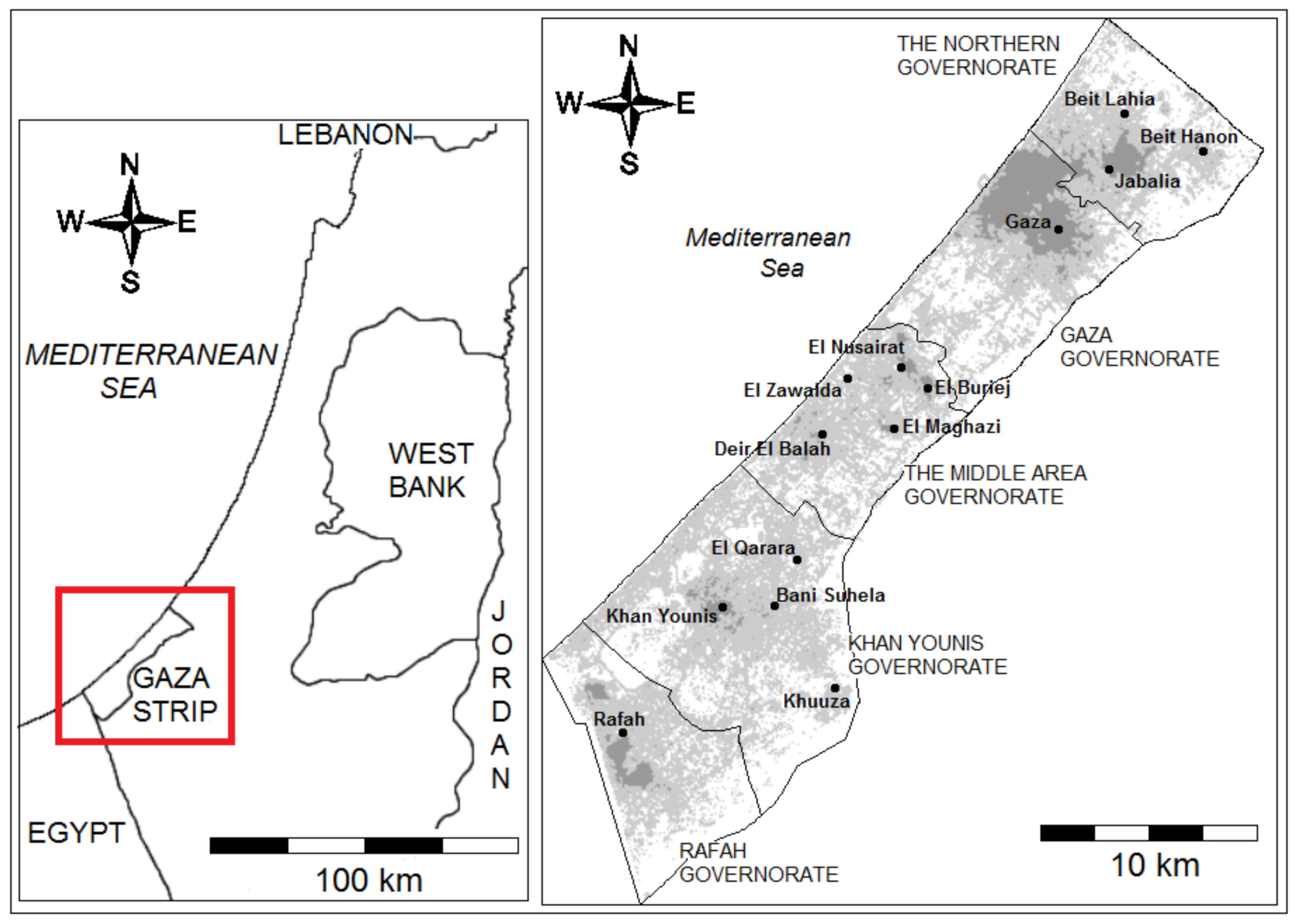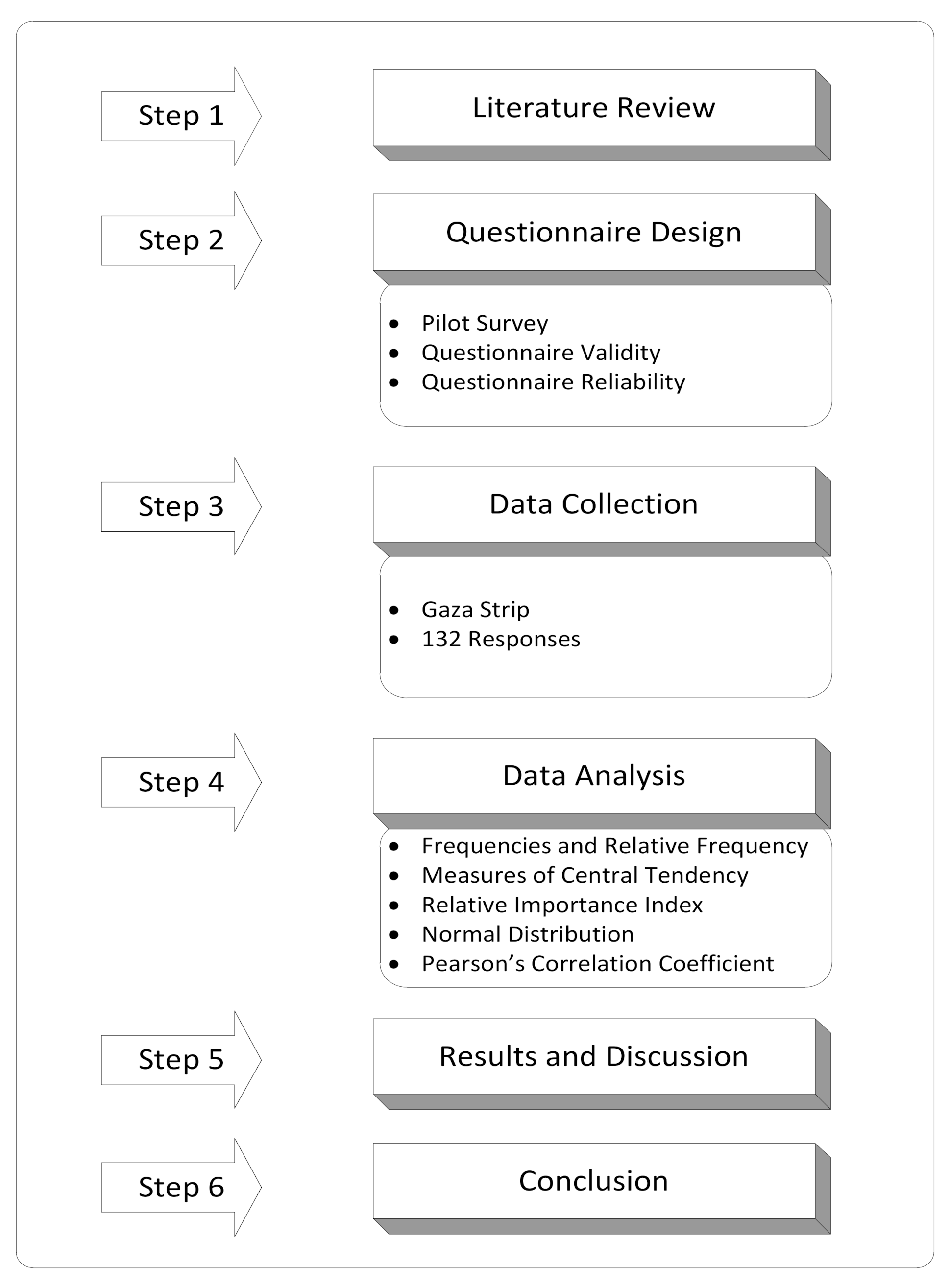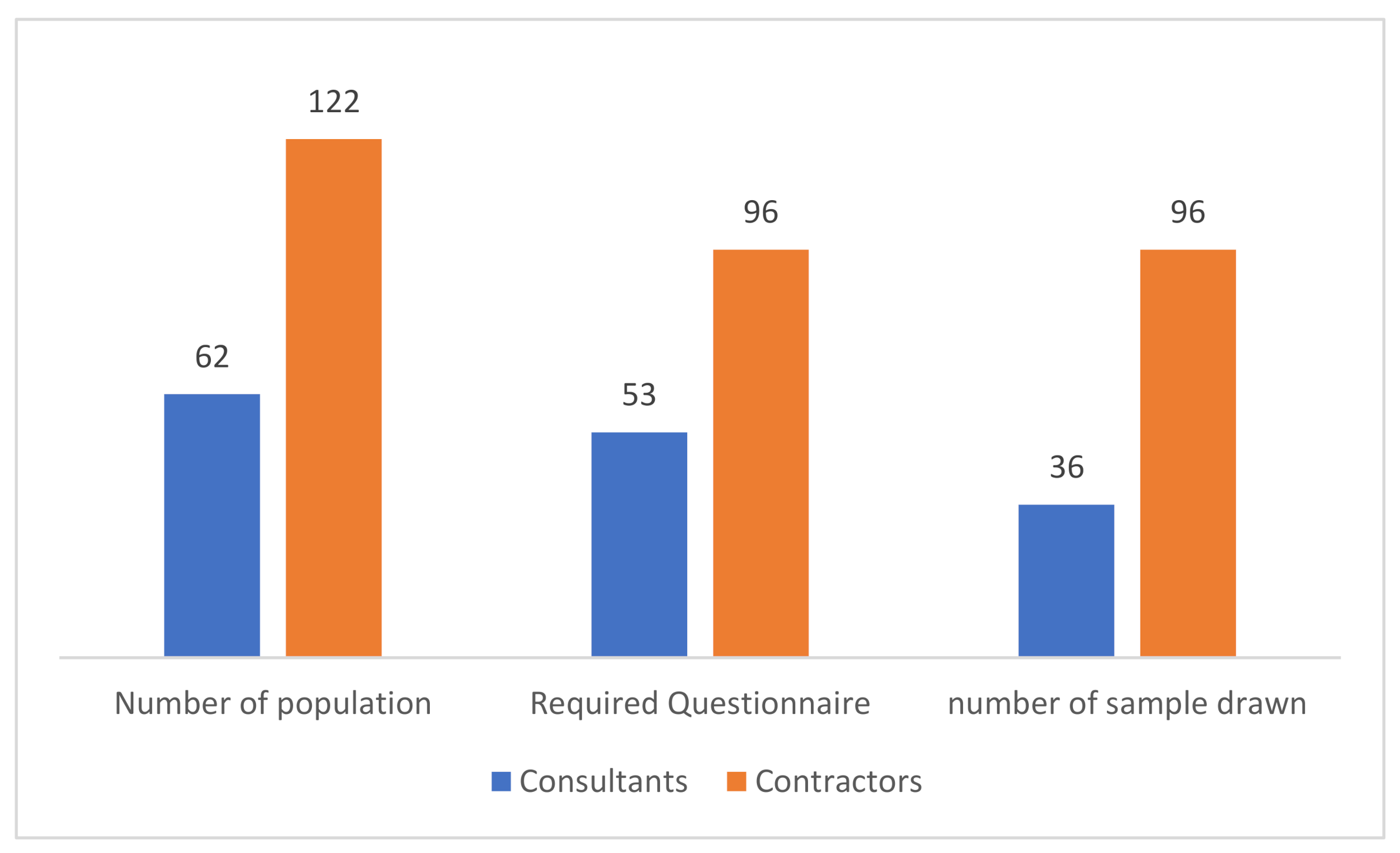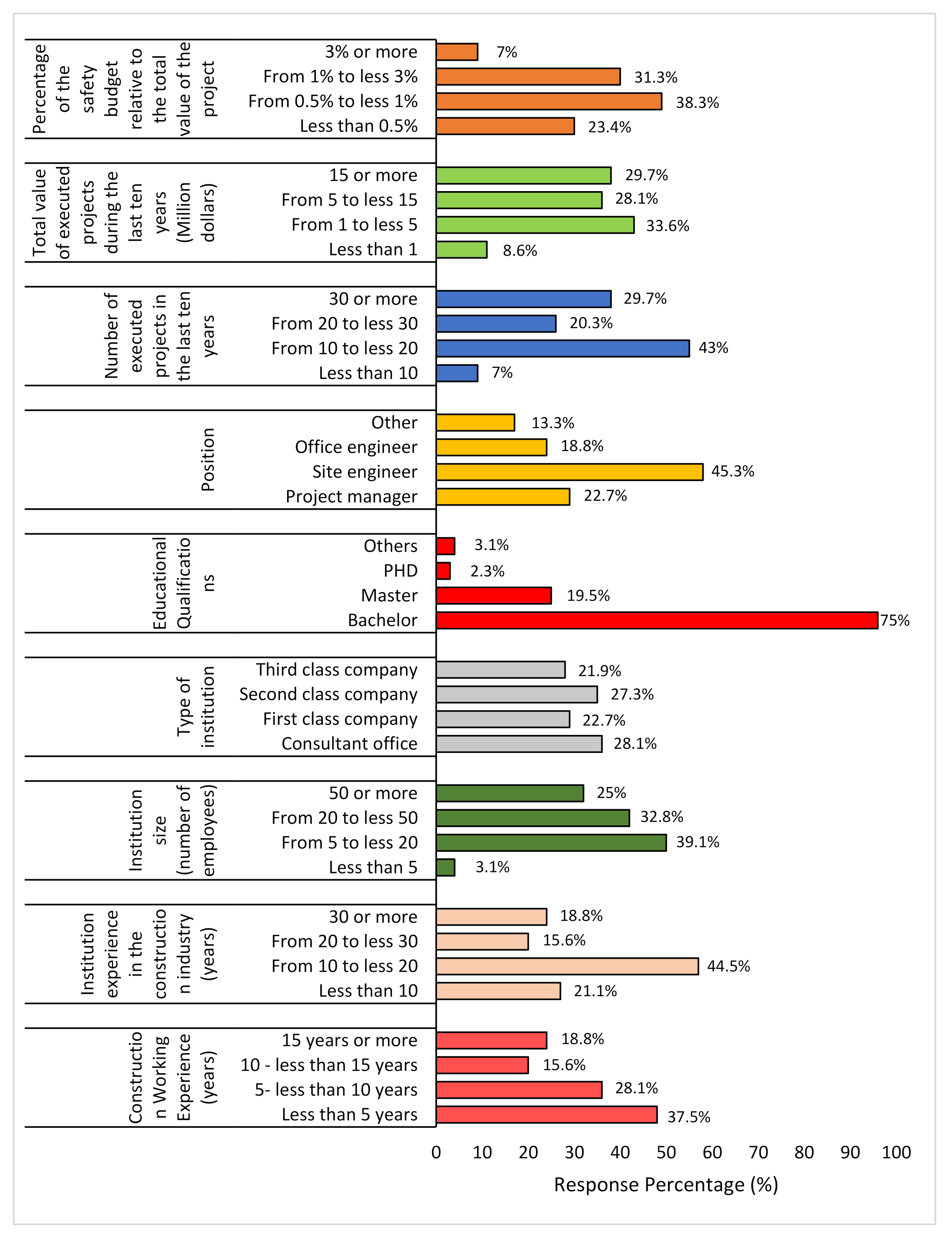1. Introduction
The construction industry contributes a valuable amount to the economy of any country, however, it is still badly affected by several issues such as cost overrun [
1,
2], time overrun [
3,
4,
5], price fluctuation due to inflation [
6,
7,
8], and most importantly due to poor safety performance [
9]. Despite these severe issues, a project gets completed, but is not declared successful because the project failed to achieve the projects’ objectives [
10,
11]. Neglecting safety measures can result both in physical damage to workers and financial losses, which can increase the direct and indirect cost of the project [
12,
13]. As per the International Labour Organization (ILO), 2.3 million workers die each year worldwide due to occupational accident, impacting 4% of world GDP [
14]. To successfully implement safety guidelines within a company, an equal effort is required by all the stakeholders of the construction industry [
15]. In developed countries, considerable attention is provided to health and safety [
16]. Whereas, in developing or underdeveloped countries the condition varies as the consideration of health and safety is far behind in its implementation [
17,
18,
19]. The scenario can be different if collaborative work for occupational health and safety is performed between developed and developing countries, where sharing of information is done to bring major reforms [
20,
21].
One of the most important functions of infrastructure projects is to develop public services and improve the daily situation, necessary to support economic and social activity. In Palestine, infrastructure projects differ from the rest of the world due to the scarcity of financial resources and the density of population distribution. Infrastructure projects require continuous management and experience of the long-term planning and development of projects in line with plans. Infrastructure projects require substantial financial investment, time commitment, and significant human and material resources. Infrastructure development in Palestine is affected by many obstacles and problems that hinder current projects and plans, and the implementation of basic and public services [
22]. One of the biggest challenges is the Israeli occupation, which controls the arrival of basic construction materials (cement, steel, and aggregates) to the Gaza Strip through long-term coordination mechanisms, requiring complex and time-consuming processes, which hinder current and future infrastructure projects [
23]. Infrastructure projects in the Gaza Strip have been severely affected by lack of construction materials, in addition to the destruction incurred during military operations.
The Gaza Strip is the south western part of Palestine, which is located on the south-eastern coast of the Mediterranean Sea. The area of the Gaza Strip is about 365 km
2, with an approximate length of 45 km, and a width between 6 and 12 km. It is confined between the Mediterranean Sea in the west, Egypt in the south, and occupied Palestine since 1948 in the east and the north, as shown in
Figure 1. The Gaza Strip is located between longitudes 34°2″ and 34°25″ E, and latitudes 31°16″ and 31°45″ N [
24].
The lack of planning and poor management in the selection and implementation of infrastructure projects suitable to current and future conditions are the problems that the Gaza Strip suffers, as there are no clear and effective criteria in determining the priorities for infrastructure projects. No priorities and long-term plans are explained for the stages of implementation of infrastructure projects [
22]. According to the last report of the Palestinian Contractors Union [
25], there were 294 classified contractors in the Gaza Strip in 2019. The construction activities are divided into five categories (roads, buildings, electromechanical, water/sewage, public works, and maintenance). Each one of these categories has five classes (from one to five). The contractor can have more than one classification in different categories of the above-mentioned five categories. The contractors of the first, second, and third classes for infrastructure works totaled 122 in the Gaza Strip in 2019.
The Gaza Strip suffers from a fragile infrastructure, however, there is growing interest in infrastructure development in various large projects, ranging from road projects, sewage plants, water desalination, electricity and others. This development should be accompanied by parallel attention to the requirements of occupational safety, especially since infrastructure projects have special characteristics among construction projects, as they relate to the public, whether in the stages of construction, maintenance, or demolition. Keeping to the discussion in consideration, a research question was established: “What are the barriers that hinder the occupational safety implementation in infrastructure projects in Gaza Strip”? Therefore, this research aims to assess the barriers to implementing occupational safety in infrastructure projects in the Gaza Strip from the consultants’ and contractors’ point of view, and with the set hypothesis: “The barriers affect the implementation of safety practices in the infrastructure sector in the Gaza Strip”.
2. Literature Review
In infrastructure projects, factors and conditions surrounding construction sites vary significantly compared with other projects; the workers must perform dangerous jobs that require high physical and mental strength for long periods. In addition to unsanitary conditions, unavailable services, messy work environments, and exposure to bad weather conditions, the impression of infrastructure construction sites is that they are disorganized and dangerous [
26]. Delivering projects on time requires effective planning of occupational safety, without exceeding costs and without significant risks or harm to the safety of workers on the project site. These are not easy targets, because construction sites are complex and crowded, and because of the constant pressures of time and constant changes in the work environment [
27,
28]. An accident at work is an unexpected event caused by an external reason, resulting in injury or death, which takes place in connection with work. In general, lack of knowledge, training, poor supervision, and the lack of safe means to carry out activities are the main causes of work accidents. In addition to negligence, complete recklessness, and indifference, the construction industry is inherently short-term, complex, and diverse, and lacks internal and external oversight. All these factors have an impact on the performance of occupational safety within the workplace [
29]. In construction, unsafe behavior is the most important factor in the occurrence of construction accidents, which leads directly from the fact that a safety culture does not exist on the worksite [
30]. Accidents are associated with a variety of reasons, and deviation from the essence of the work may be the main cause [
31]. Masayuki [
32] recognized one of the methods for inculcating a safety culture in the workplace is by giving awards to the workers. Active communication and information transfer between management and workers have been suggested to produce better safety standards, and improve safety policies [
33]. Discussing occupational safety in frequent meetings raises the level of safety in planning, which leads to the significant development of occupational safety; while reviewing occupational safety during progress meetings makes predicting problems easy and specific [
34]. Wong and Gray [
35], Tam and Zeng [
36], and Ghani and Baki [
37] listed various responsibilities and specifications that safety engineers should undertake to ensure the occupational safety of a project, such as: the number of safety engineers should be appropriate to the volume of project, and the safety engineer should have powers to stop all events in the projects in case of hazards happening.
There are four categories of barrier affecting safety performance in infrastructure projects that should be investigated; these are: (1) management, (2) safety culture, (3) behavior, and (4) awareness [
38]. Safety performance can be influenced by factors including the top management’s and project managers’ poor safety awareness, poor safety resources, absence of training, and irresponsible operations [
36]. Safety management can be regarded as the totality of practices implemented by the management of an organization to control hazards, so that occupational accidents and injuries are ultimately prevented, i.e., different strategies and activities focusing on the safety of the workers [
39]. Safety management, thus, involves a wide range of both formal and informal practices, focusing on standardized activities, such as risk assessment on the one hand, and managers actively showing a commitment to safety on the other [
40]. Safety management relates to the actual practices, roles, and functions associated with remaining safe [
41]. The application of effective occupational safety management in the workplace makes the existing system safer and less susceptible to accidents and injuries. Most of the research conducted on occupational safety systems has shown a clear increase in injury rates due to insufficient occupational safety regulations in the workplace [
42,
43].
The contractor should perform an internal audit of their safety management program, and take advantage of past safety experience to periodically update safety plans [
44]. The selection of contractors bidding for construction projects should be based on occupational safety considerations, including an assessment of the contractor’s previous occupational safety performance, current programs and practices, and the contractor’s attitude towards safety [
45,
46]. The safety management needs to be aware of an accident and record it, to establish a better course of action for future accident or incident prevention. If the accident is not reported or detailed, it is impossible to identify the causes [
47].
The negligence of workers is a cause of workplace accidents, but is not the only reason, as failure to control occupational safety within the project is a shared responsibility with management. It is assumed that occupational safety systems have a financial allocation to the fullest extent possible, and that the management is fully aware of the cost involved, measure the level of accidents, and improve the safety performance of the project, through reduced risks and the number of injuries [
48].
In Kuwait, construction company management believed that occupational safety procedures and requirements increase the cost of construction. However, it was also found that the costs of accidents and safety measures were not considered in the contractor’s offer, and only the cost of insurance of the project was considered, among all elements of occupational safety [
49]. Improving the quality of occupational safety needs the adoption of an effective and complete safety approach at the management level; this approach should be clear, through careful consideration of each serious activity identified at the design stage or subsequent stages, in addition to holding training programs on occupational safety and health for old and new workers, where the training is based on the correct decisions in dealing with accidents associated with their workplace [
50]. Infrastructure and construction risks generally coincide with many things, but infrastructure is affected by many restrictions, requirements, and safety aspects that are generally not fully controlled, such as in terms of infrastructure, or occupational safety related to the care of “third party” public security. These restrictions may be related to political or social matters [
51]. Knowing and evaluating past incidents and preparing their records is critical for management that wants to minimize future incidents in their company. Writing reports, directing them to the competent department, and reviewing them to take the correct action has a significant role in minimizing accidents, in addition to a follow-up program for evaluating the effectiveness of the procedures.
Safety climate is a summary concept describing the safety ethic in a company or workplace which is reflected in workers “beliefs about safety and is supposed to forecast the way workers behave concerning safety in that workplace” [
50]. The study conducted by Dedobbeleer and Béland [
52] on construction workers, suggested that the management’s commitment to safety, and workers’ involvement in safety were the two most important factors impacting the safety climate. In a study on road workers, two separate sets of principles were found for workers and supervisors, both of which include attitudes towards occupational safety, and supplied variables in labor requirements and occupational safety as part of the work [
53].
Important requirements include alerting new workers to potential hazards during their work and making an effort to comply with safety regulations, including wearing personal protective equipment (such as safety glasses and hard hats), placing barricades, and deploying warning signs around drilling places [
54]. The training of administrative staff, with appropriate awareness and competence for the requirements of occupational safety, leads to obtaining an effective program and plan for the performance of occupational safety and its implementation, especially to senior management because they are drawing the outlines of a positive occupational safety culture, and applying it to the work and workers as required [
55].
Implementation of occupational safety requirements on the worksite needs a true safety culture and appropriate feedback from workers. Activating occupational safety training and guidance programs is essential to improving the workers’ safety culture and attitudes towards safety, in addition to educating workers about safety rules and procedures, and training workers on safe working methods. Well-trained workers are allowed to carry out dangerous and important work. Workers’ participation in occupational safety programs should be mandatory, as they are exposed to daily work hazards [
56].
Pratt and Fosbroke [
57] emphasized that the best technique to develop occupational safety in the workplace is to change the behavior and performance of individuals with the requirements of occupational safety. The development of occupational safety is reactive and behavior-based, and is an effective tool for increasing occupational safety in the workplace; this includes allowing workers to monitor each other to support the development of safety habits through discussion and analysis tools. This method might be considered to have a limited impact, due to the many variations that occur daily in the workplace, so that the proposed improvements are not feasible, this therefore may require the increased behavioral awareness of supervisors, to be more aware of existing physical risks [
58].
A main cause of accidents is the poor safety performance of the workers, as one from a combination of contributing causes [
38]. Moreover, in recent years safety performance has increasingly come to center around the safety-related behaviors of workers [
59]. Occupational safety behaviors give a clear indication of the presence or absence of occupational safety in the workplace [
60]. These behaviors, in turn, are often located in a broader social and organizational context, where a multitude of conditions affect safety outcomes [
61].
Difficulties in communication with foreign workers can also cause accidents on the construction site [
62]. The safety issue faced is due to some of the workers not speaking or understanding the local language. Effective communication might help both parties, namely the safety supervisor and the worker, to have better coordination at the construction site [
37]. Good communication affects the implementation of the safety program; when the management communicates openly with the worker, the worker will report on unsafe working practices and hazardous environments [
63].
Unsafe behaviors are often the source of many accidents, together with poor working conditions, malfunctioning equipment, poor systems, and poorly designed processes; all of which can encourage unsafe behaviors. While, a company’s attitude towards safe work is an important factor affecting the implementation of occupational safety requirements. It is not enough to provide safe equipment, systems, and procedures if the culture does not promote safe and healthy work [
64]. A vast majority of the studies focusing on safety climate and safety culture thus have pointed towards the importance of safety management, including a leadership style that promotes trust and open communication, and makes safety a prioritized area [
65]. From the literature review carried out, various barriers were highlighted and modified, as shown in
Table 1, as per the working environment of the Gaza Strip.













